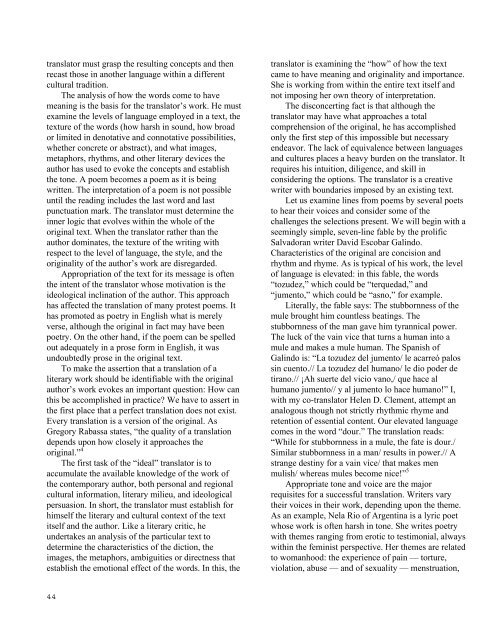their - The University of Texas at Dallas
their - The University of Texas at Dallas
their - The University of Texas at Dallas
You also want an ePaper? Increase the reach of your titles
YUMPU automatically turns print PDFs into web optimized ePapers that Google loves.
transl<strong>at</strong>or must grasp the resulting concepts and then<br />
recast those in another language within a different<br />
cultural tradition.<br />
<strong>The</strong> analysis <strong>of</strong> how the words come to have<br />
meaning is the basis for the transl<strong>at</strong>or’s work. He must<br />
examine the levels <strong>of</strong> language employed in a text, the<br />
texture <strong>of</strong> the words (how harsh in sound, how broad<br />
or limited in denot<strong>at</strong>ive and connot<strong>at</strong>ive possibilities,<br />
whether concrete or abstract), and wh<strong>at</strong> images,<br />
metaphors, rhythms, and other literary devices the<br />
author has used to evoke the concepts and establish<br />
the tone. A poem becomes a poem as it is being<br />
written. <strong>The</strong> interpret<strong>at</strong>ion <strong>of</strong> a poem is not possible<br />
until the reading includes the last word and last<br />
punctu<strong>at</strong>ion mark. <strong>The</strong> transl<strong>at</strong>or must determine the<br />
inner logic th<strong>at</strong> evolves within the whole <strong>of</strong> the<br />
original text. When the transl<strong>at</strong>or r<strong>at</strong>her than the<br />
author domin<strong>at</strong>es, the texture <strong>of</strong> the writing with<br />
respect to the level <strong>of</strong> language, the style, and the<br />
originality <strong>of</strong> the author’s work are disregarded.<br />
Appropri<strong>at</strong>ion <strong>of</strong> the text for its message is <strong>of</strong>ten<br />
the intent <strong>of</strong> the transl<strong>at</strong>or whose motiv<strong>at</strong>ion is the<br />
ideological inclin<strong>at</strong>ion <strong>of</strong> the author. This approach<br />
has affected the transl<strong>at</strong>ion <strong>of</strong> many protest poems. It<br />
has promoted as poetry in English wh<strong>at</strong> is merely<br />
verse, although the original in fact may have been<br />
poetry. On the other hand, if the poem can be spelled<br />
out adequ<strong>at</strong>ely in a prose form in English, it was<br />
undoubtedly prose in the original text.<br />
To make the assertion th<strong>at</strong> a transl<strong>at</strong>ion <strong>of</strong> a<br />
literary work should be identifiable with the original<br />
author’s work evokes an important question: How can<br />
this be accomplished in practice We have to assert in<br />
the first place th<strong>at</strong> a perfect transl<strong>at</strong>ion does not exist.<br />
Every transl<strong>at</strong>ion is a version <strong>of</strong> the original. As<br />
Gregory Rabassa st<strong>at</strong>es, “the quality <strong>of</strong> a transl<strong>at</strong>ion<br />
depends upon how closely it approaches the<br />
original.” 4<br />
<strong>The</strong> first task <strong>of</strong> the “ideal” transl<strong>at</strong>or is to<br />
accumul<strong>at</strong>e the available knowledge <strong>of</strong> the work <strong>of</strong><br />
the contemporary author, both personal and regional<br />
cultural inform<strong>at</strong>ion, literary milieu, and ideological<br />
persuasion. In short, the transl<strong>at</strong>or must establish for<br />
himself the literary and cultural context <strong>of</strong> the text<br />
itself and the author. Like a literary critic, he<br />
undertakes an analysis <strong>of</strong> the particular text to<br />
determine the characteristics <strong>of</strong> the diction, the<br />
images, the metaphors, ambiguities or directness th<strong>at</strong><br />
establish the emotional effect <strong>of</strong> the words. In this, the<br />
transl<strong>at</strong>or is examining the “how” <strong>of</strong> how the text<br />
came to have meaning and originality and importance.<br />
She is working from within the entire text itself and<br />
not imposing her own theory <strong>of</strong> interpret<strong>at</strong>ion.<br />
<strong>The</strong> disconcerting fact is th<strong>at</strong> although the<br />
transl<strong>at</strong>or may have wh<strong>at</strong> approaches a total<br />
comprehension <strong>of</strong> the original, he has accomplished<br />
only the first step <strong>of</strong> this impossible but necessary<br />
endeavor. <strong>The</strong> lack <strong>of</strong> equivalence between languages<br />
and cultures places a heavy burden on the transl<strong>at</strong>or. It<br />
requires his intuition, diligence, and skill in<br />
considering the options. <strong>The</strong> transl<strong>at</strong>or is a cre<strong>at</strong>ive<br />
writer with boundaries imposed by an existing text.<br />
Let us examine lines from poems by several poets<br />
to hear <strong>their</strong> voices and consider some <strong>of</strong> the<br />
challenges the selections present. We will begin with a<br />
seemingly simple, seven-line fable by the prolific<br />
Salvadoran writer David Escobar Galindo.<br />
Characteristics <strong>of</strong> the original are concision and<br />
rhythm and rhyme. As is typical <strong>of</strong> his work, the level<br />
<strong>of</strong> language is elev<strong>at</strong>ed: in this fable, the words<br />
“tozudez,” which could be “terquedad,” and<br />
“jumento,” which could be “asno,” for example.<br />
Literally, the fable says: <strong>The</strong> stubbornness <strong>of</strong> the<br />
mule brought him countless be<strong>at</strong>ings. <strong>The</strong><br />
stubbornness <strong>of</strong> the man gave him tyrannical power.<br />
<strong>The</strong> luck <strong>of</strong> the vain vice th<strong>at</strong> turns a human into a<br />
mule and makes a mule human. <strong>The</strong> Spanish <strong>of</strong><br />
Galindo is: “La tozudez del jumento/ le acarreó palos<br />
sin cuento.// La tozudez del humano/ le dio poder de<br />
tirano.// ¡Ah suerte del vicio vano,/ que hace al<br />
humano jumento// y al jumento lo hace humano!” I,<br />
with my co-transl<strong>at</strong>or Helen D. Clement, <strong>at</strong>tempt an<br />
analogous though not strictly rhythmic rhyme and<br />
retention <strong>of</strong> essential content. Our elev<strong>at</strong>ed language<br />
comes in the word “dour.” <strong>The</strong> transl<strong>at</strong>ion reads:<br />
“While for stubbornness in a mule, the f<strong>at</strong>e is dour./<br />
Similar stubbornness in a man/ results in power.// A<br />
strange destiny for a vain vice/ th<strong>at</strong> makes men<br />
mulish/ whereas mules become nice!” 5<br />
Appropri<strong>at</strong>e tone and voice are the major<br />
requisites for a successful transl<strong>at</strong>ion. Writers vary<br />
<strong>their</strong> voices in <strong>their</strong> work, depending upon the theme.<br />
As an example, Nela Rio <strong>of</strong> Argentina is a lyric poet<br />
whose work is <strong>of</strong>ten harsh in tone. She writes poetry<br />
with themes ranging from erotic to testimonial, always<br />
within the feminist perspective. Her themes are rel<strong>at</strong>ed<br />
to womanhood: the experience <strong>of</strong> pain — torture,<br />
viol<strong>at</strong>ion, abuse — and <strong>of</strong> sexuality — menstru<strong>at</strong>ion,<br />
44

















